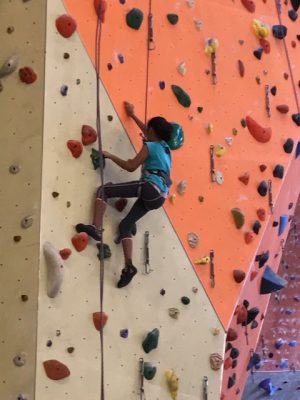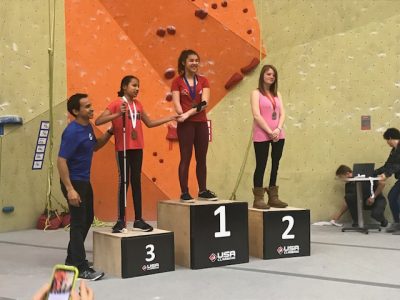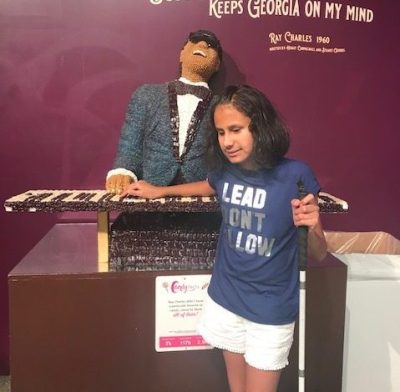By June Converse.
Assume People Can
“Be conscious of your bias and try to correct them before they become judgments.” ~ Raveena, age 14
Recently we posted an article about Universal Design. As we always like to do, this article takes Universal Design off the page and into the classroom. While interviewing Jessica, Stacy and Raveena, my view of Universal Design expanded.
Yes, Universal Design is about providing the resources for all students to participate. But after this interview, I realized Universal Design is not about equipment or training. Universal Design is an attitude.
Jessica Forte and Stacy Floyd are teachers at the Atlanta Girls’ School. Raveena, who is completely blind, enrolled in the school midway through her 6th grade year and is now in ninth grade. She is also one of the most articulate people I have ever met. Together, these three women embody the Universal Design Attitude.

How Can We?
They never say, “We Can’t Do This.” With every activity the attitude is “How Can We Make This Happen?”
In the months before Raveena started school, Jessica and Stacy prioritized locating resources and finding the best adaptations. They were committed that instead of changing the curriculum to accommodate Raveena, they would find a way to include Raveena in the planned curriculum. They didn’t drop volleyball from the curriculum. They didn’t eliminate badminton or not play hockey. There was no need to remove an activity. They committed to “figuring it out”.
Figuring It Out
It’s true that putting a student who is visually impaired on the volleyball court can be worrisome. But when you set your mind to full inclusion, finding resources is not difficult. When you allow the student the dignity to choose and accept her own risk you can work together to make it happen. There are training videos and special equipment. There are professionals who are available and eager to help educators and coaches. Jessica and Stacy reached out to Dr. Jeanine Wert, professor at Columbus State University and director of Camp Abilities in Columbus, Georgia. Dr. J visited the Atlanta Girls’ School, providing demonstrations and encouragement.
But Jessica and Stacy say Raveena “was the key”. Raveena had “the answers”.
When it was time to play volleyball, Stacy admits she was nervous. “Raveena can’t see the ball and because the ball doesn’t bounce, she can’t hear it either.” But being nervous didn’t mean not trying.
Together with the teacher for the visually impaired at her school, they put their heads together and figured it out. They used a playground ball with bells. They played the game with one bounce. Jessica became Raveena’s eyes. She used verbal cues and her hands to show Raveena the “ready” position.
In badminton, a favorite for most students, the “rackets are swinging, and girls are everywhere.” But they figured it out by creating a bell-birdie.
Ultimate ball (similar to ultimate frisbee) was another challenge that felt daunting. Rather than sit Raveena on the sideline, they paired her with another person. Raveena and her partner ran together. The partner caught and Raveena threw. Together they played ultimate ball.
They kept working “until it worked”.

It Was Beautiful
Universal Design is not just about teaching a student who is visually impaired how to play volleyball. Universal Design benefits everyone. Universal Design changes attitudes.
Goalball is a team sport designed specifically for people with visual impairments where sighted players are required to wear a blindfold. Jessica presented goalball to the students. The sighted students were “scared at first”. Jessica found the best way to teach goalball was to let Raveena guide the process. Raveena taught the students how to operate in the space. She guided her friends to sit in a circle and roll the beep ball to one another.
Before the goalball unit was over, Jessica and Raveena had created an attitude of empathy. Empathy is not feeling sorry for someone – Raveena and others who are visually impaired are not seeking pity. Empathy is about understanding, about walking in someone else’s shoes. Elise is an example of empathy in action.
Elise is not a teacher or coach. She is Raveena’s peer. She showed Raveena body positions or broke down movements to clarify verbal cues. Without being asked, Elise stepped in and stepped up. “It was beautiful,” Jessica said.
Still Learning
Stacy, Jessica, and Raveena are still learning. During her fitness unit, Stacy would sometimes use her hands to demonstrate, “Hands here, not here.” Most of the time – almost all of the time – Stacy would catch herself and give a different verbal cue.
“Raveena is very patient,” Stacy said.
I asked Raveena how she approaches someone when she needs better communication or a different adaptation. “I start with ‘gentle talk’. Or I send an email or speak to the teacher during office hours.”
Universal Design is not about perfection. Universal Design is about patient communication.
Never on the Bench
Because they have an attitude of “how can we”, Raveena always tries. The goal, of course, is 100% inclusion. But there are occasions when that’s not possible. But there is always a way to be physically fit. She has never “sat on the bench”.
What we believe becomes how we think and act. Stacy, Jessica, Raveena and her parents believe Raveena can.

Raveena Does
Because her attitude is “Yes, I can,” Raveena placed 3rd in the US Adapted Rock-Climbing competition when she was twelve years old. She climbs at Stone Summit Atlanta and has climbed the 60-foot wall. Now that she’s 14, she can work towards the International Rock- Climbing Competition.
Raveena has also been active in Brazilian jiu-jitsu and was a member of the Jump Rope Club.
Jump Rope?
Hayley, Raveena’s mother, explained that in 3rd grade Raveena wanted to be a member of her school’s Jump Rope Club. Hayley admits they were a little dumbfounded. How do you teach a child who is blind how to jump rope? They enlisted a young, athletic paraprofessional. She would hold Raveena’s hips and say “jump”. It was a slow process but by the end of the year, Raveena was doing 100+ revolutions.
They figured it out.
So Can We
Raveena and her teachers strive to “inspire girls to lead lives of purpose.” They found the resources, asked for help, bought or made the equipment. None of that matters without the attitude. They inspire because they are inspiring.
What is Universal Design? What is Inclusion?
- An attitude of fairness.
- An attitude of confidence.
- An attitude of communication.
- An attitude of acceptance.
- An attitude of “Yes, I can. Let’s figure out how.”
Raveena is planning to pursue a career in social justice. I wanted to end this article with her words because these words encompass Universal Design.
“It doesn’t seem like we are united in fairness, empathy or compassion. I want to change that.”
“Be conscious of your bias and try to correct them before they become judgments.”
Gratitude
- I can’t thank Raveena enough. You are one of the most articulate and compassionate people I have ever been privileged to know.
- Stacy and Jessica, I wish we could bottle your attitude and your enthusiasm. You are exactly what the next generation of girls need.
One more thing:
Raveena shared with me how much Jeanine Wert means to her. Jeanine is a “bundle of energy” who “creates opportunities”. She has been a buddy runner for Raveena and in many ways Jeanine has taught Raveena how to succeed. She has helped Raveena embrace, “Yes, I can.”
Resources
For videos and other materials to help you include: https://www.campabilities.org/instructional-materials.html



